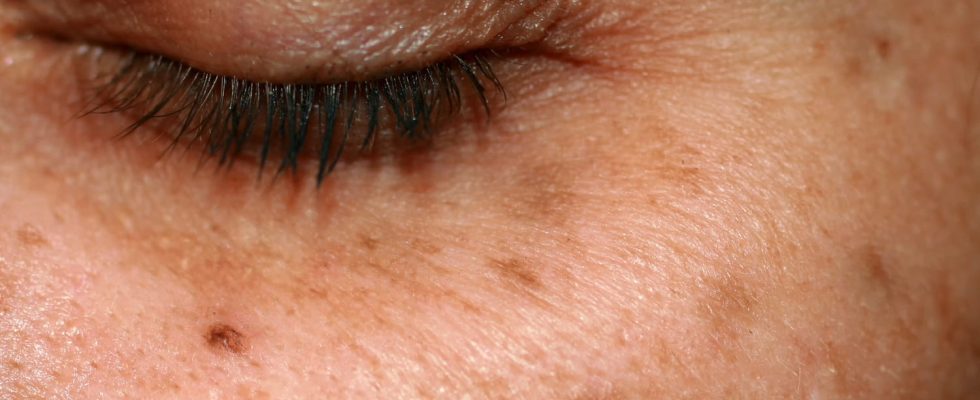Often confused with an age spot, Dubreuilh melanoma (face, back, hands) is a relatively rare cancer but can become aggressive.
THE Dubreuilh melanoma is a type of melanoma either form of skin cancer. Initially, it is superficial, developing into the epidermis, then over time it can become invasive if not taken care of. This melanoma is often confused with skin spots benign related to age and sun exposure, which makes diagnosis difficult. He is more diagnosed in people over 60 years old. “They say it comes a bit later in life than other types of melanoma, but often it’s because it’s not not diagnosed early“, explains Pr Caroline Robert, head of the dermatology department at theGustave Roussy Institute.
Definition: what is a Dubreuilh melanoma?
THE Dubreuilh melanoma represented 5 to 10% of melanomas. He usually sits on the facebut also on other areas exposed to the sun such as back and hands. It appears as a pigmented patch of dark brown or black color, flat and irregular which extends on the surface over time. Contrary to nodular melanoma which is very aggressive because it immediately spreads in depth, Dubreuilh’s melanoma has a particular arrangement on the skin and extends gradually, horizontally, over several years. The evolution of Dubreuilh’s melanoma is rather slow.
What are the symptoms of Dubreuilh melanoma?
Dubreuilh’s melanoma takes the form ofa dark brown or black pigmented spotflat and non-homogeneous which evolves very slowly on an area exposed to the sun, most often the face, but sometimes on back and hands.
Photo of a Dubreuilh melanoma
What causes Dubreuilh melanoma?
Dubreuilh’s melanoma is linked to repeated exposure to natural (sun) or artificial (UV cabin) ultraviolet light.
“Dubreuilh’s melanoma is difficult to diagnose because it can easily be confused with benign pigmented spots : seborrheic keratoses, actinic keratoses for example, which are very common especially when you have fair skin. The dermatologist can helpa dermatoscope which offers an enlarged and more detailed vision and makes it possible to obtain a more precise diagnosis”, says the dermatologist. If the lesion seems suspicious to him, the specialist performs excision under local anesthesia. The diagnosis will then be confirmed by pathological analysiswhich will also determine the thickness of Dubreuilh’s melanoma, which determines its severity.
Treatment depends on the extent of the cancer and its stage of development. When the melanoma is localized, surgery is the standard treatment. When it is extensive, metastatic and inoperable, the first-line treatment is intravenous checkpoint inhibitor immunotherapy.
Thanks to Pr Caroline Robert, head of the dermatology department at the Gustave Roussy Institute
